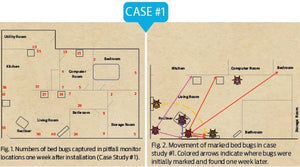Bed Bug Mobility
Here are some interesting and useful facts about bed bug mobility:
What Bed Bugs Can and Cannot Climb
Bed bugs can climb surfaces with texture very well. Wood, paper, cardboard, fabric, typical home walls–bed bugs can climb these easily.
Bed bugs have difficulty climbing slick, non-porous surfaces. Slick metal, plastic, glass or ceramic are very difficult for bed bugs to climb. There is some evidence that some bed bugs might be able to eventually climb these slick non-porous surfaces–so they are not necessarily 100% fool proof–but they do remain a very helpful deterrent. This is why we suggest using metal bed frames in Step 1 of our 8-Step Approach.
Bed Bugs Can Move Fairly Fast
Bed bugs can travel over 16 feet in 5 minutes.
When Bed Bugs Are Most Active
Bed bugs tend to be nocturnal and come out to feed at night, when their host is sleeping. However, they will adapt to the sleep cycle of their host. So if the person works the night shift and sleeps during the day, bed bugs will adjust and be more active and feed during the day.
Also, hungry bed bugs will come out even during the day to look for a meal.
Hungry bed bugs tend to move around more than satiated bed bugs, presumably to look for a meal. Bed bugs tend to feed once per week, so they tend to be most active as they look for a meal.
Where Bed Bugs Tend to Harbor
With light infestations bed bugs tend to remain in harborages near where the person is stationary–the bed, the recliner, the sofa.
With very heavy infestations some bed bugs will roam very far from initial harborages and wind up in harboring in new, unexpected locations that can be quite far from the host.
In this interesting study, researchers tracked movements of bed bugs in two extremely infested dwellings. Bed bugs roamed to very far locations from where they were initially spotted. Scientists aren’t sure why they roamed so far–maybe in search of a new food source or new harborages.
Conclusions
When battling bed bugs, you should think about their mobility.
When making your bed into a Safe Zone, as we describe in Step 1, don’t allow bed sheets to touch the floor, because bed bugs can easily climb fabric. Do use a metal frame and bed intercepters, which are much more difficult for bed bugs to climb.
Since bed bugs can roam quite far, it makes sense that they might move through wall voids and electrical conduits from one unit to another in apartment buildings. This is why it is important to seal cracks and crevices as described in Step 5.
The fact that bed bugs move around and can climb textured surfaces also explains why they can wind up climbing up the side of a suitcase and getting into a person’s luggage in a hotel room. This is often how people bring home bed bugs from a hotel and wind up infesting their own homes.
Posted by Andrew Havlis


